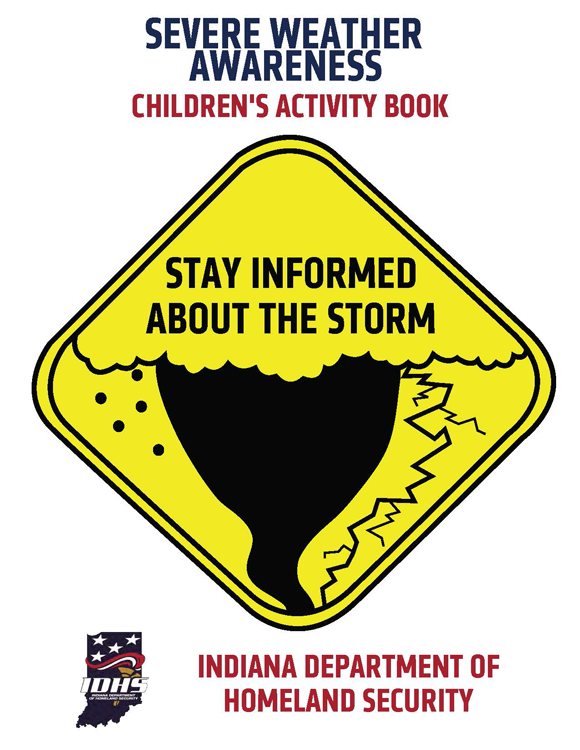Severe Weather Preparedness
- Get Prepared
- Nature Safety
- Current: Severe Weather Preparedness

Severe Weather Preparedness Week 2025 is March 9-15
View the governor's Severe Weather Preparedness Week 2025 proclamation
Each year, IDHS collaborates with the National Weather Service (NWS) during Severe Weather Preparedness Week to remind and educate Hoosiers about seasonal severe weather threats and how to effectively prepare for them. Throughout the week, IDHS will share severe weather safety tips on social media. Follow IDHS and use the hashtags #SevereWx and #SWPW!
Quick Tips
- When you hear thunder, you are within striking distance of lightning. Go indoors when you hear thunder.
- Consider how you would be alerted if there were a tornado warning. Sirens are meant to be heard outside and cannot be relied on if you are indoors. Have a NOAA weather radio or weather alert app.
- Have a location designated as your safe spot regardless of what kind of building you are in. A basement or storm shelter is best, but an interior room, stairway or hall without a window or door to the outside is acceptable.
- Find out what flood insurance coverage would cost to add to your policy for your home. New policies take 30 days to become effective, so you need to add coverage well before any anticipated flooding.
- Know how to be alerted to possible severe weather, make a plan of where to take shelter or evacuate, and keep an emergency disaster kit ready at all times.
Storms, floods and tornadoes are common occurrences to Hoosiers. Practice these tips below to stay prepared for these weather events and not only minimize their effects, but also save lives.


Statewide Tornado Drill
Every Hoosier business, school and family should participate in the statewide tornado drill each year. The drill allows you to practice where to go, what to do and what to take so you are prepared in the event of a real tornado warning.
At about 10:15 a.m. Eastern on Tuesday, March 11, 2025, NWS will issue a test tornado warning alert, which will be shared through most notification systems, including the statewide Emergency Alert System (EAS).
Wherever you are at that time, practice your tornado safety plan. There will be no follow-up alerts issued by the NWS to mark the end of the statewide tornado drill. It ends when your business, school or family feels that you have adequately practiced your safety procedures.
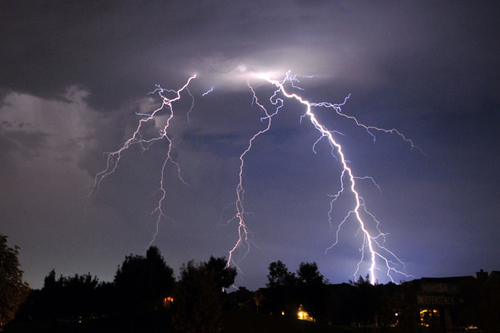
Lightning strikes in Marion County, June 2010

Lightning strikes in Marion County, June 2010
Before Severe Storms Arrive
Take Steps to Reduce Risks
Check weather forecasts daily and plan outdoor activities to be near a secure shelter if a storm is possible. Put pets indoors ahead of time. Park your vehicle in a covered area to avoid damage from hail or debris.
Do Not Ignore Thunder
Thunder is caused by lightning. When heard from a nearby storm, then lightning is within 10 miles and can strike you. Seek shelter until at least 30 minutes after the last sound of thunder.
Have a Plan and a Kit
Know how to be alerted to possible severe weather, make a plan of where to take shelter or evacuate, and keep an emergency disaster kit ready at all times.
Do Not Rely Only on Tornado Sirens
Consider how you would be alerted if there were a tornado warning. Tornado sirens are designed to be heard outdoors and may not be heard inside. Have a weather radio with an alarm tone and battery backup to receive alerts. Also make sure your mobile device is set up to get warnings.
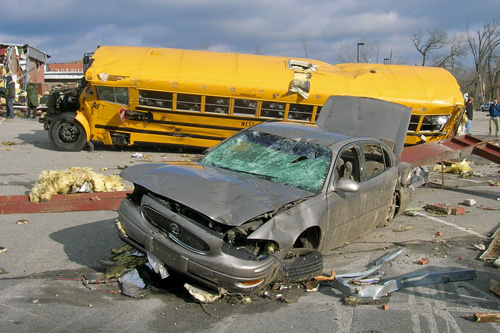
Tornado damage in Henryville, March 2012

Tornado damage in Henryville, March 2012
Tornado Safety Reminders
Do Not Take Shelter Under a Highway Bridge
Never seek overpasses as shelter from hail or tornadoes. You are still exposed to flying debris, and crowds of vehicles can block roadways and prevent others from reaching real shelter.
Take Shelter in a Strong Building or Underground
Do not try to outrun a tornado in your vehicle. Drive to the nearest shelter and go inside. If there is no time, pull over and park. Keep your seat belt on, put your head below the windows and protect your head.
Go to the Lowest Level of the Building
Find an interior room away from doors, windows and outer walls. Better yet, go to a safe room, basement or storm cellar. If in a mobile home, immediately find a more sturdy, ground-built house or shelter.
Do Not Stand Outside or Near Windows
Flying debris causes the most injuries and fatalities during tornadoes. Debris, including broken glass, moving at high speeds can easily penetrate clothing and skin, so get into an interior room without windows. Use a helmet, blanket or mattress as protection for your head and neck. This protects the most vulnerable parts of your body from flying debris.
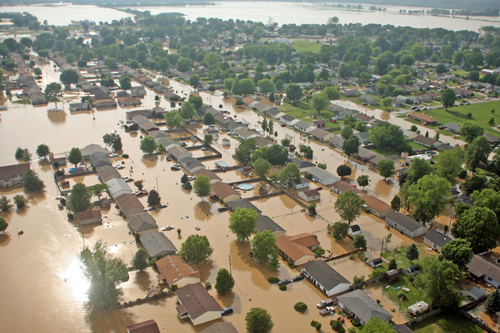
Widespread flooding statewide, June 2008

Widespread flooding statewide, June 2008
Be Prepared for Flooding
Consider Flood Insurance
Standard homeowner's and renter's insurance policies do not include flood insurance protection. Visit in.gov/floodinsurance to learn about flood insurance. New policies take 30 days to become effective, so act quickly to beat spring floods caused by melting snow and spring rains.
Did You Know?
- Just 1 inch of water can cause $25,000 of damage to an average 2,500 square-foot, one-story home.
- Indiana had 64 flooding or heavy rain events in 2024.
Make a Plan and Have a Kit
Make sure disaster kits are portable for easy transport if evacuation is necessary. Disaster kits should be tailored to household needs. Create a map of multiple possible evacuation routes.
Stay Out of the Water
Floodwaters can contain hazards such as waste and contaminants, downed power lines, vehicles, signs and trees. Even a few inches of swift-moving water can knock an adult over. Stay out and find another route.
Do Not Drive Into Floodwaters
More than half of all flood-related drownings are caused by driving a vehicle into the flooded area. As little as 2 feet of water can cause most cars to float, so play it safe and turn around.
Resources
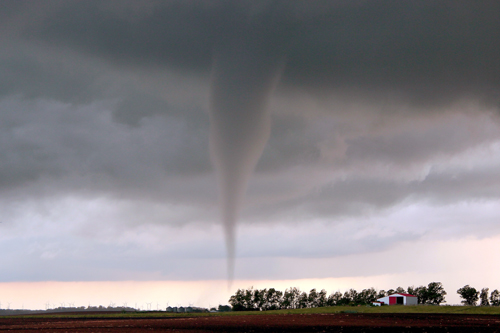
Tornado in White County, May 2017

Tornado in White County, May 2017
Become a Storm Spotter
The National Weather Service (NWS) offers free storm spotter trainings during the spring. These classes teach you what county officials and NWS need to know from spotters to issue warnings accurately.
Look up your NWS office and then select from the list below to view trainings near you:
Websites
- Disaster Kits
Indiana Department of Homeland Security - Disaster Plans
Indiana Department of Homeland Security - Flood Insurance
State of Indiana - Lightning Safety Tips
Indiana Department of Homeland Security - Severe Weather and Flood Preparedness Week
National Weather Service - Tornado Shelters
Indiana Department of Homeland Security

